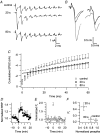Dynamics of the readily releasable pool during post-tetanic potentiation in the rat calyx of Held synapse
- PMID: 17363387
- PMCID: PMC2075193
- DOI: 10.1113/jphysiol.2006.127365
Dynamics of the readily releasable pool during post-tetanic potentiation in the rat calyx of Held synapse
Abstract
The size of the readily releasable pool (RRP) of vesicles was measured in control conditions and during post-tetanic potentiation (PTP) in a large glutamatergic terminal called the calyx of Held. We measured excitatory postsynaptic currents evoked by a high frequency train of action potentials in slices of 4-11-day-old rats. After a tetanus the cumulative release during such a train was enlarged by approximately 50%, indicating that the size of the RRP was increased. The amount of enhancement depended on the duration and frequency of the tetanus and on the age of the rat. After the tetanus, the size of the RRP decayed more slowly (t(1/2)=10 versus 3 min) back to control values than the release probability. This difference was mainly due to a very fast initial decay of the release probability, which had a time constant compatible with an augmentation phase (tau approximately 30 s). The overall decay of PTP at physiological temperature was not different from room temperature, but the increase in release probability (P(r)) was restricted to the first minute after the tetanus. Thereafter PTP was dominated by an increase in the size of the RRP. We conclude that due to the short lifetime of the increase in release probability, the contribution of the increase in RRP size during post-tetanic potentiation is more significant at physiological temperature.
Figures







Similar articles
-
Post-tetanic potentiation in the rat calyx of Held synapse.J Physiol. 2005 Apr 1;564(Pt 1):173-87. doi: 10.1113/jphysiol.2004.079160. Epub 2005 Feb 3. J Physiol. 2005. PMID: 15695246 Free PMC article.
-
Activity-dependent changes in temporal components of neurotransmission at the juvenile mouse calyx of Held synapse.J Physiol. 2007 Jun 1;581(Pt 2):581-602. doi: 10.1113/jphysiol.2007.129833. Epub 2007 Mar 8. J Physiol. 2007. PMID: 17347264 Free PMC article.
-
The pool of fast releasing vesicles is augmented by myosin light chain kinase inhibition at the calyx of Held synapse.J Neurophysiol. 2008 Apr;99(4):1810-24. doi: 10.1152/jn.00949.2007. Epub 2008 Feb 6. J Neurophysiol. 2008. PMID: 18256166
-
Merits and Limitations of Vesicle Pool Models in View of Heterogeneous Populations of Synaptic Vesicles.Neuron. 2015 Sep 23;87(6):1131-1142. doi: 10.1016/j.neuron.2015.08.038. Neuron. 2015. PMID: 26402599 Review.
-
Molecular mechanisms governing Ca(2+) regulation of evoked and spontaneous release.Nat Neurosci. 2015 Jul;18(7):935-41. doi: 10.1038/nn.4044. Nat Neurosci. 2015. PMID: 26108721 Review.
Cited by
-
Presynaptic release probability and readily releasable pool size are regulated by two independent mechanisms during posttetanic potentiation at the calyx of Held synapse.J Neurosci. 2008 Aug 6;28(32):7945-53. doi: 10.1523/JNEUROSCI.2165-08.2008. J Neurosci. 2008. PMID: 18685020 Free PMC article.
-
Dynamin-1 deletion enhances post-tetanic potentiation and quantal size after tetanic stimulation at the calyx of Held.J Physiol. 2017 Jan 1;595(1):193-206. doi: 10.1113/JP271937. Epub 2016 Jun 27. J Physiol. 2017. PMID: 27229184 Free PMC article.
-
Plasticity-dependent, full detonation at hippocampal mossy fiber-CA3 pyramidal neuron synapses.Elife. 2016 Oct 25;5:e17977. doi: 10.7554/eLife.17977. Elife. 2016. PMID: 27780032 Free PMC article.
-
Developmental changes in short-term plasticity at the rat calyx of Held synapse.J Neurosci. 2011 Aug 10;31(32):11706-17. doi: 10.1523/JNEUROSCI.1995-11.2011. J Neurosci. 2011. PMID: 21832200 Free PMC article.
-
Ethanol modulation of synaptic plasticity.Neuropharmacology. 2011 Dec;61(7):1097-108. doi: 10.1016/j.neuropharm.2010.12.028. Epub 2010 Dec 31. Neuropharmacology. 2011. PMID: 21195719 Free PMC article. Review.
References
-
- Awatramani GB, Price GD, Trussell LO. Modulation of transmitter release by presynaptic resting potential and background calcium levels. Neuron. 2005;48:109–121. - PubMed
-
- Bollmann JH, Sakmann B, Borst JGG. Calcium sensitivity of glutamate release in a calyx-type terminal. Science. 2000;289:953–957. - PubMed
-
- Borst JGG, Sakmann B. Calcium influx and transmitter release in a fast CNS synapse. Nature. 1996;383:431–434. - PubMed
Publication types
MeSH terms
Substances
LinkOut - more resources
Full Text Sources
Other Literature Sources
Research Materials

